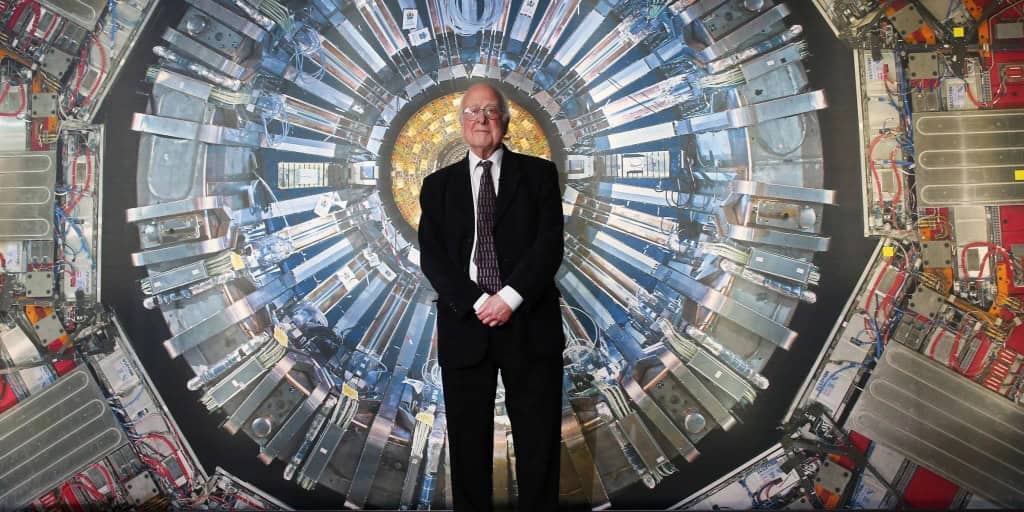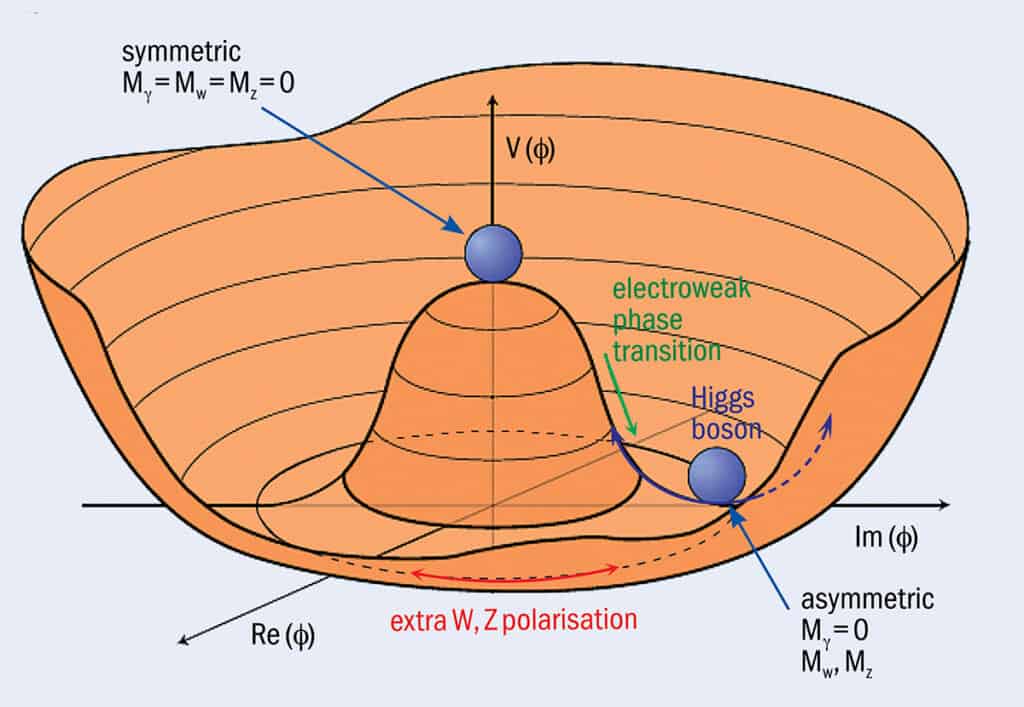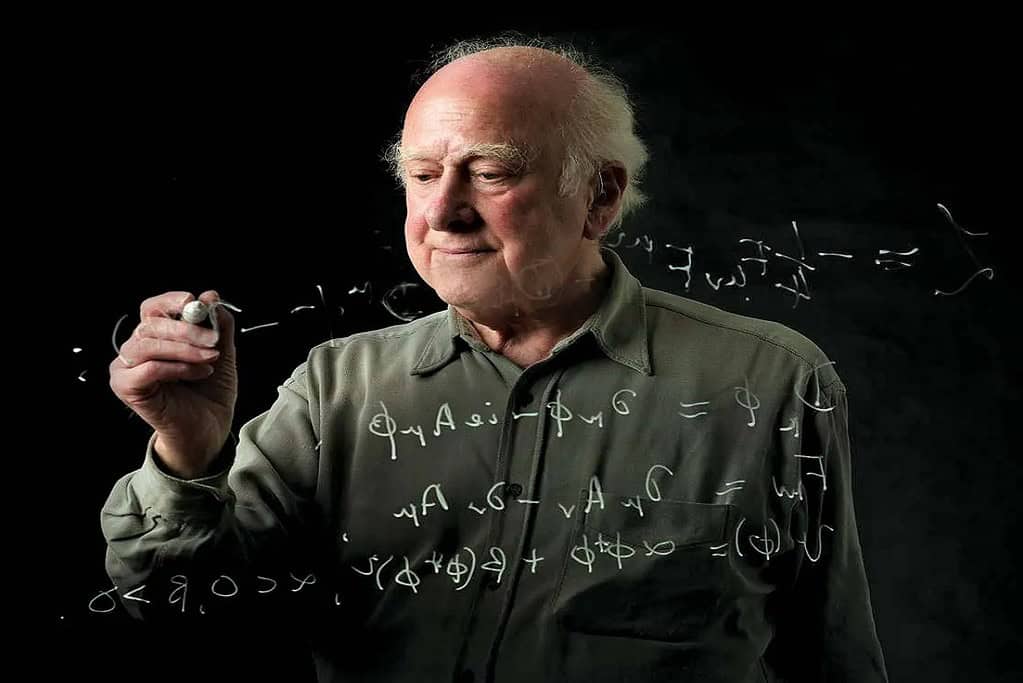Peter Higgs, One of The Discoverer of ‘God Particle’, Passes Away

The celebrated British Physicist Peter Higgs passed away at the age of 94 in Edinburgh on Monday, 8th April 2024. The University of Edinburgh, where he taught as a professor for 36 long years until his retirement in 1996, announced his passing away. He was an Emeritus Professor at the Edinburgh University. According to the statement of Edinburgh University, he passed away at home in peace after a ‘short illness’.
Peter Higgs is renowned for discovering the framework for the Brout-Engert-Higgs Field, popularly known as the ‘God Particle’. Alan Walker – a close friend of Peter Higgs and a fellow physicist at the University of Edinburgh – told the New York Times that Peter Higgs was suffering from a blood disorder. His family is in mourning and wishes to be left alone by the media.
Read Articles About Big Bang and Creation of Our Universe
- Big Bang: An Incredible Start of Universe 14 Billion Years Ago
- Our Universe: An Incredible Journey of 13.7 Billion Years
Early Life, Schooling, and Higher Education

Peter Higgs was born in the city of Newcastle, metropolitan county of Tyne and Wear, northeastern England, on 29th May 1929. He was born to Thomas Ware Higgs and his wife Gertrude Maude Higgs. Thomas Ware Higgs was a sound engineer for the BBC. Early in his life, Peter Higgs had to move a lot with his father and mother due to the ongoing World War II. Due to suffering from asthma, he was unable to continue with his formal school studies and had to opt for studying in-house.
At the age of 12, Peter Higgs restarted his formal schooling at Cotham Grammar School in Bristol. Here he came to know about Paul Dirac, who was an alumnus of the school and a Nobel laureate. He was inspired by Paul Dirac’s achievements and took an interest in mathematics. His father also encouraged him to pursue his passion for math. At the age of 17, he came to the City of London School and continued his studies in Mathematics. Here, he would learn about new happenings in the Quantum Field and take an interest in Physics.
In 1947, Peter Higgs came to King’s College London and started his formal studies in Physics. In 1950, he received his Bachelor’s Degree in Physics, and just one year later, completed his Master’s Degree. He would continue his studies at King’s College London and pursue Doctoral studies in Theoretical Molecular Physics. In 1954, Peter Higgs completed his Ph.D. degree from the King’s College London with a thesis paper about Molecular Vibration.
Career As A Physicist

Before Peter Higgs completed his PhD, he was awarded the prestigious ‘Royal Commission for the Exhibition of 1851 research fellowship’ for two years. This fellowship grants young scientists to follow their research interests in the fields of science, engineering, applied research, and industrial design. He spent the first year of the fellowship at King’s College London. Then he spent 2nd year of the fellowship, from 1954-55, at the University of Edinburgh – marking the start of a lifelong professional relationship with the University. In 1956 he became a Senior Research Fellow at the University.
After that, in 1956, Peter Higgs went back to London, took up an ICI Research Fellowship, and became a research fellow at the University of London. He would continue as a research fellow for that year. Then he would move to Imperial College for a year. The Imperial College was part of the University of London at that time. On a side note, Imperial College became an independent University in 2007. Then in 1959 he became a Lecturer in Mathematics at the University and would continue till 1960.
In 1960, Peter Higgs returned to the University of Edinburgh and joined ‘Tait Institute’ as a Lecturer of Mathematical Physics. He would spend the rest of his professional career at this university till he retired in 1996. In 1964, in this very University where Peter Higgs thought about a mechanism that would give masses to some of the subatomic particles. Later in 1970, he became a ‘Reader’ at the University. In 1974 he became a ‘Fellow’ of the Royal Society of Edinburgh. In 1980, Peter Higgs was promoted to ‘Personal Chair’ of Theoretical Physics. After his retirement in 1996, Peter Higgs would become a lifelong ‘Professor Emeritus’ at the University of Edinburgh.
Read Articles About Solar System and Its Planets
- Solar System: 10 Astonishing Uniqueness of our star system
- Jupiter – The Captivating New King of Moons
- With 62 New Moons, Saturn Dethrones Jupiter as King of Moons
Recognitions and Honors

Apart from the coveted Nobel Prize, Peter Higgs received many other honors and recognition for his works in Mathematics and Theoretical Physics. In 1974, he became a Fellow of the Royal Society of Edinburgh. In 1998, he became a Fellow at his PhD University – King’s College London. In the next year, he became an Honorary Fellow at the Institute of Physics. In 2013, after the discovery of the Brout-Engert-Higgs Field by CERN, Peter Higgs received an Honorary Fellow from the Royal Scottish Society of Arts. In the same year, he became an Honorary Fellow of the London Science Museum.
In 1981, Peter Higgs was awarded the ‘Hughes Medal’ by the Royal Society. In 1990, the Saltire Society and the Royal Bank of Scotland conferred the ‘Scottish Science Award’. In 1997, the Institute of Physics presented him with the ‘Paul Dirac Medal and Prize’. This is the same ‘Paul Dirac’ who was the alumnus of Cotham Grammar School in Bristol where Peter Higgs went for early education.
In 2010, the American Physical Society awarded Peter Higgs with ‘J. J. Sakurai Prize’. In 2013, he was the co-recipient (along with CERN) of the ‘Edinburgh Medal’ by the Edinburgh International Science Festival for the discovery of the Brout-Engert-Higgs Field. In the same year, he received the ‘Premios Princesa de Asturias’ award from the Princess of Asturias Foundation.
Brout-Engert-Higgs Field or The ‘God Particle’

While working at the University of Edinburgh, Peter Higgs came out with the idea of a symmetry-breaking field or elementary particle which would give the massless particles their masses. In 1960, Japanese-American Physicist Yochiro Nambu and two Japanese Physicists – Makoto Kobayashi & Toshihide Maskawa- discovered the mechanism through which an unstable but symmetric particle spontaneously goes into an asymmetric but stable position. This is called ‘spontaneous symmetry breaking’. All three physicists were awarded the Nobel Prize for this discovery.
This prior work in symmetry breaking would inspire Peter Higgs to work out the equation for a field that would explain how some particles (like protons) acquire mass while other massless particles (like photons) remain massless. Some other scientists – Robert Brout, Francois Englert, C.R Hagen, Tom Kibble, and Gerald Guralnik – were also working with the same idea. Initially, the idea did not get much attraction from the scientific community. The initial attempts by Peter Higgs to get his idea published met with a lot of roadblocks. Later he would refine his idea while other works on the same idea by different scientists would start to take shape.
With all these different but converging ideas, the Brout-Engert-Higgs mechanism would take shape in the early 1970s. According to this mechanism, there has to be a scalar boson with zero (integer) spin and no electric charge that would give certain particles their mass (like protons) while letting other particles (like photons) go massless.
This mechanism became an integral part of our understanding of particle physics so much so that without the existence of the Brout-Engert-Higgs mechanism, the current version of physics itself would have collapsed. Hence this mechanism was dubbed as ‘Goddamed Particle’ by another Nobel Laureate, Leon Lederman, in his 1993 book which was later modified to be named ‘God Particle’ by the publishers of the book. The name stuck in the popular imagination and the Brout-Engert-Higgs mechanism became ‘God Particle’. Of course, Peter Higgs and other physicists were not very content with the extravagant naming.
Read About Indian & Chinese Space Agencies and Their Achievements
- With Chandrayaan 3 Mission, ISRO Aims for A Glorious Future
- As Chandrayaan 3 Touches Moon, India Basks in Pride and Glory
- China’s Space Program: 5 Incredible Achievements
Search For Higgs Boson

The particle would remain elusive for almost four decades after its final conceptualization by Peter Higgs and other scientists. Scientists and Physicists knew that the Brout-Engert-Higgs mechanism was present and there would be an elementary particle – Higgs Boson/Higgs field – that would give mass to certain elementary particles. But for a long time, they did not have a powerful enough particle collider to find the elusive field or particle. On top of that, the Higgs Boson is supposed to be very unstable and would disintegrate into other fundamental particles upon its appearance.
In earlier particle colliders, the experiments were inconclusive. Also, there was no direct or indirect observation of Higgs Boson in the large expansion of the cosmos. Also, the proposed mass for the Higgs Boson had a huge range. The first semblance of success would come in Large Electron-Positron Collider in CERN which worked from 1989 to 2000. The LEP Collider would not find the elusive particle however, it would give some ideas about the mass of the Higgs Boson.
In 2001, it was replaced by the Large Hadron Collider, and the hope to find the Higgs Boson was intensified. Subsequent experiments would not find the particle conclusively but would narrow down the expected mass of the particle. Finally in 2012, at the Large Hadron Collider, scientists found a new Boson particle with a mass of 125.3 GeV (CMS) with a plus-minus error of 0.15 GeV that has all the characteristics of Higgs Boson/Higgs Field. It makes the newly found Higgs Boson 130 times more massive than a proton.
Peter Higgs was present at the press conference where CERN scientists announced the discovery which led to elation and relief for the scientists as without the assistance of the Higgs Boson, entire particle physics would have collapsed and they would have to completely rethink the the structure of the Universe. François Englert and Peter Higgs were awarded the Nobel Prize jointly for their contribution to figuring out the Brout-Engert-Higgs mechanism.
How Higgs Boson/Higgs Field Gives Mass to Particles

Every elementary particle that has been discovered till now is represented by its respective quantum field. Quantum fields are the fields that propagate all around the Universe. Any exhalation in a particular field by a specific amount of energy will create a particle associated with that field. Higgs Boson is the exhalation in the Higgs Field.
It is this field through which the particles interact and get mass (quarks) or do not interact and do not get mass (photons). The exhalation in the Higgs Field would create Higgs Boson and we have observed this Higgs Boson in the Large Hadron Collider. Since we have observed the Higgs Boson, we can soundly conclude that the Higgs Field exists, that the Brout-Engert-Higgs mechanism does work, and that it gives mass to certain particles.
How the Brout-Engert-Higgs mechanism works and the Higgs field gives mass to certain particles required works of decades and needed some of the best minds to come together. It is not possible to explain it in this one article. We will try to explain it in very simple terms. Generally, all the quantum fields in the Universe, while conserving the symmetry, have zero VEV – Vacuum Expectation Value. Higgs Filed on the other hand is an exception and has a VEV of 246 GeV. Hence, Higgs Filed or Higgs Boson is not at its lowest possible energy state and is in a False Vacuum state.
This unique property allows Higgs Field to propagate throughout the Universe and to carry the Weak Hypercharge at all and any possible values. Weak Hypercharge is one of the quantum qualities of the Weak Isospin which in turn is related to the Weak Interaction or Weak Force. Weak force is one of the fundamental forces of nature and is responsible for radioactive decay.
Some elementary particles, while going through the Higgs Field, take or release the Weak Hypercharge. The Weak Hypercharge of these elementary particles constantly changes while going through the Higgs Field. This interaction makes these elementary particles slow down and feel the mass. The particles that interact intensely get more mass while the particles that interact less intensely become less heavy. The particles that do not exchange Weak Hypercharge, do not interact with the Higgs Field don’t feel the mass, and continue to go through the Universe at the maximum speed that is the light speed. A photon is one such particle that does not interact with the Higgs Field and does not gain mass.
Read NASA Related Articles
- NASA’s MOXIE Creates 122 gm O2, A Big Step of Mars Colonization
- Top 10 Incredible Discoveries Made by JWST James Webb Space Telescope
Higgs Boson May Destroy The Universe

Discovered by Peter Higgs, Higgs Boson is one of the most important elementary particles of the standard model of particle physics. Without it, our understanding of the quantum world and the entire cosmos would have been incomplete. However, as important as it might be, Higgs Boson could end our entire Universe in the blink of an eye.
As mentioned earlier, Higgs Boson is the only particle that has a non-zero Vacuum Expectation Value. It means that the Higgs Boson is at a valley of low energy state but it may not be its lowest energy level. Hence, Higgs Boson could be unstable and is in a ‘metastate’. If Higgs Boson is in a ‘metastate’ then it could leave its ‘metastate’ in case it is exalted by a sufficient amount of high energy. Then the Higgs Boson could fall to its true lowest energy level. Cosmic events or objects (supernovas, blackholes, magnetars, quasars, gamma-ray bursts, etc) that release high amounts of energy, could potentially trigger this event.
However, this event may also occur without the need for any energy. The Higgs Boson could break its current state and move to the lowest possible energy level by quantum tunneling. In the quantum realm, all particles act as both a particle and a wave and they all have their respective wave functions. If some parts of the wave function of the Higgs Boson fall outside the current ‘metastate’, then Higgs Boson could spontaneously fall to the lowest energy level.
This could prove catastrophic to the Universe as a whole. Higgs Filed provides mass to certain particles and these particles make up stars, galaxies, planets, moons, asteroids, humans, plants, animals, etc. If the Higgs Field is in a ‘metastate’, then the entire Universe is at a higher energy level, and, given the right conditions, the Universe may fall into the true lowest energy levels, ending the Universe as we know it.
If Higgs Field, through high energy exhalation or thorough quantum tunneling, falls into its true vacuum, a three-dimensional spherical area may form within space-time. The space inside this area will contain Higgs Field with true lowest energy state and at the periphery of this area the Higgs Boson will have ‘metastate’. Through propagation, the Higgs Field inside the area will try to expand and convert the Higgs Field in the periphery to its lowest energy state. If the Higgs field inside the three-dimensional sphere is able to overcome the inward pressure exerted by the Higgs Field in the periphery, then the sphere will grow at the speed of light and will engulf the entire Universe.
Learn About 4 Forces of Nature That Might Destroy The Universe
Certain End of The Universe: 4 Forces of Nature to Watch Out For
In Conclusion
Peter Higgs was one of the most influential scientific figures in our modern time. His efforts to establish the Brout-Engert-Higgs mechanism gave us an understanding of the nature of the Universe. Without this mechanism, entire particle physics would have collapsed. The scientific world and the world at large mourn the passing of Peter Higgs – a shy and humble person and an extremely talented physicist.
Read Other Science & Space Related Articles
- Space Science: 6 Essential Reasons to Keep Investing in It
- 5 Amazing Properties of Time Which Defy Common Sense
- 10 Factors for Emergence of Intelligent Life in The Universe




